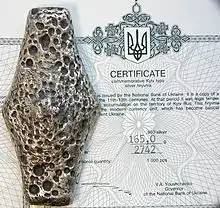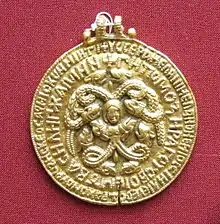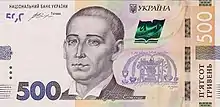History of Ukrainian hryvnia
The history of the Ukrainian hryvnia refers to more than 1200 years since the Kyiv princes established the silver ignots called hryvnias as a mean of money and a measure of weight during early Kyiv Rus'. The hryvnia has been the national currency of Ukraine since 1996.
Etymology

The word “hryvnia” in Kyiv Rus' firstly meant a decoration worn at the nape of the neck during Kyiv Rus' times and often served as a measure of weight at that time. The first mention of "hryvnia" in the meaning of currency is found in "The Tale of Bygone Years" between 8 and 9 centuries.[1] The chronicle tells: Prince Oleg the Prophet, coming from the North, began to rule in Kyiv and "established to give the Vikings from Novgorod three hundred hryvnias a year, for peace. That is, already in the 8-9 centuries when conducting trade operations or paying tribute, the hryvnia was used as a measure of weight and counting.
In the 11 century, the word "hryvnia" got a different meaning — weight. During 11 century silver hryvnia weighing between 160 and 205 grams, depending on the type appeared in Kyiv Rus'.
There were several types of hryvnias. The most common one in circulation was called the Kyiv hryvnia. It had a hexagonal shape and weighed 150 grams of silver. This money existed before the Tatar invasion. In addition, there were the Novgorod hryvnias, initially known only in the north-western lands. The Novgorod hryvnias had the appearance of long silver sticks and weighed 240 grams. The Chernihiv hryvnia was transitional from Kyiv's to Novgorod's hryvnia. It had a very close shape to Kyiv's and in weight as Novgorod's hryvnia.
Coin production

The first Ukrainian money made of gold and silver were produced during the rule of Kyiv Prince Volodymyr the Great. These coins had an image of a trident which was the symbol of Kyivan princes. The name of the coins were zlatnyks (gold coins) and sriblianyks (silver coins). The two sides of the golden coin depicted Prince Volodymyr and Jesus Christ. The silver coins were minted by Kyivan princes as well as in other principalities (e.g. Chernihiv, Novgorod).
In 12-14 centuries Kyiv Rus' appeared in a decline and didn't mint coins. The population and feudals began using silver ingots called hryvnias to replace the deficient gold or silver coins minted by Kyiv Rus' princes previously.
In the middle of the 14 century the new coins started being minted by Lviv and Kyiv rulers. Thus, hryvnia (silver ingot) slowly went out of circulation and remained as a unit of counting.
1917-1921
_front_side.jpg.webp)
During the Ukrainian Revolution in 1917–1921, the establishment of the national currency was of a primary importance for Ukrainian state. On 22 December 1917, the Central Council established Ukraine's state bank. Mykhailo Kryvetskyi was appointed to the director of the bank. He signed the first banknote (100 karbovanets banknote) issued by Ukrainian People's Republic on 5 January 1918. One karbovanets equaled to 0.767 grams of gold.
In the design of the 100 karbovanets banknote there has been used the trident — a major symbol depicted on golden and silver coins minted by Volodymyr the Great.
On 1 March 1918, the Central Council introduced a new currency, the hryvnia, which consisted of 100 shahs and equaled 1/2 of a previously issued by the government Ukrainian karbovanets.
In April 1918, Hetman Pavlo Skoropadsky again introduced the karbovanets as the main currency of Ukraine. It consisted of 200 shahs. Banknotes of 10, 25, 50, 100, 250 and 1,000 karbovanets were issued.
Since 1991

In 1991 the National Bank of Ukraine started emission of coupons karbovanets. In September 1996, a currency reform was performed by National Bank of Ukraine and its head Viktor Yushchenko. As a result, a new currency called hryvnia was introduced.
The National Bank of Ukraine issued 1, 2, 5, 10, 20, 50, 100 banknotes and minted 1, 2, 5, 10, 25 and 50 kopiikas.
As for early 2020 the National Bank of Ukraine issued 10, 20, 50, 100, 200, 500 and 1000 banknotes with the plan to stop issuing 10-hryvnia banknote denomination in June and replacing it with a coin.[2]
External links
- Дмитрієнко М. Ф. Грошовий обіг в Україні 1917—1920 // Енциклопедія історії України : у 10 т. / редкол.: В. А. Смолій (голова) та ін. ; Інститут історії України НАН України. — К. : Наук. думка, 2004. — Т. 2 : Г — Д. — С. 223. — 518 с. : іл. — ISBN 966-00-0405-2.
- History of hryvnia. National Bank of Ukraine
- From the history of Ukrainian money (in Ukrainian).
References
- Laurentian chronicles 1377: The Tale of Bygone Years. Saint Petersburg: Academy of Science (SSSR). 1926–1928.
- "New 10-Hryvnia Coin in Circulation in June". National Bank of Ukraine. Retrieved 2020-05-26.